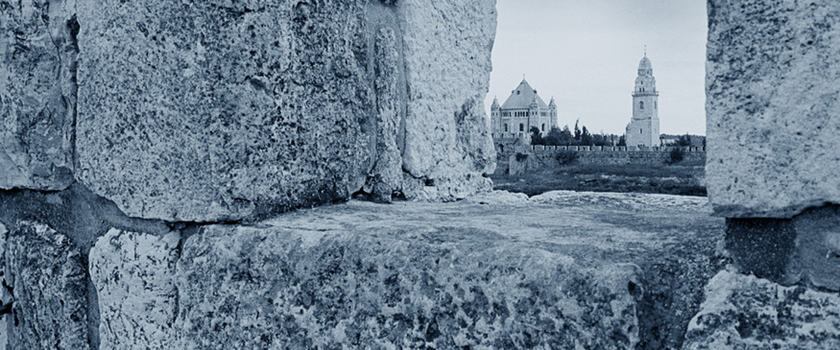 Dormition Abbey on Mount Zion (© by Frieder Blickle).
The bell tower and lead-covered cupola of Dormition tower noticeably over Mount Zion and mark the skyline of the Old City of Jerusalem from various directions. For many pilgrims and local Christians the German Marian shrine is one of the most important holy places in the whole land.
Dormition Abbey on Mount Zion (© by Frieder Blickle).
The bell tower and lead-covered cupola of Dormition tower noticeably over Mount Zion and mark the skyline of the Old City of Jerusalem from various directions. For many pilgrims and local Christians the German Marian shrine is one of the most important holy places in the whole land.
Like a Girl with the Charm of a mature Woman
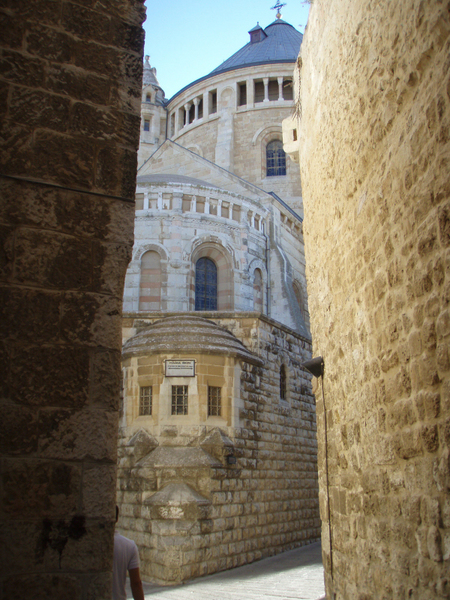 View from a side lane of the Dormition Basilica.
Historical truth and scientific certainty are hardly certain in a city formed by so many beliefs and soaked with the blood of so many faithful. All the more important and characteristic then become precisely these beliefs and traditions that are handed on from generation to generation.
View from a side lane of the Dormition Basilica.
Historical truth and scientific certainty are hardly certain in a city formed by so many beliefs and soaked with the blood of so many faithful. All the more important and characteristic then become precisely these beliefs and traditions that are handed on from generation to generation.
That occurs in oral form, sometimes also in written form and in individual cases also in stone. Modern Jerusalem stands on a whole collection of such oral, written and archaeological traditions and beliefs. Much of what one sees and observes at first sight may be young in the context of three thousand years of the city's history. Yet the roots reach deep.
The changing history of the place
Our Dormition Basilica is also relatively young with its barely hundred year history. But it stands on old stone and oral testimonies of Christian belief. When the room of the Last Supper was lost during the destruction of Jerusalem by the Roman troops in 70 A.D., a Jewish-Christian synogogue was built on Mount Zion, later designated as the “Church of the Apostles.” In the fourth century it was enlarged to become a small church. At the beginning of the fifth century a large Byzantine basilica known as “Hagia Sion” was erected in its place. which however, was already destroyed during the Persian invasion of 614. Only in the 12th century was a new church built by the crusaders, larger than all its predecessors and called “Santa Maria in Monte Sion.” However, when the Muslims retook the city from the crusaders in 1187, many traces of the brief Christian period were wiped away. The stone remains of Santa Maria are found today only in the area of the present-day Room of the Last Supper and deep in the ground beneath our monastery and our church.
A the end of the 19th century, when the Germans undertook to acquire the plot of land on Mount Zion, it was still a field of rubble behind which arose the Nebu Daoud (Prophet David) complex.
During the centuries, the local Christians have preserved the memory of two stones that they honored as stones from the house where Mary lived and died. Both these stones have found a place on the ground floor on the outer side of the tower, where even now oriental Christians come to pray.
100 Year History of a Church
On Reformation Day in 1898, after several years of diplomatic activity, this point had been reached: after Emperor Wilhelm II of Germany had dedicated the German Evangelical Church of the Redeemer in the morning, in the afternoon he handed over the piece of land for Dormition to the German Association for the Holy Land
Enlarge picture
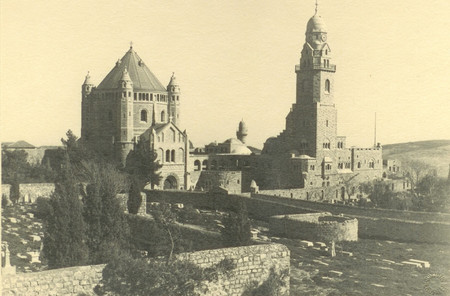 On October 7 the corner stone was laid. Local workers and artisans of every confession, religion, language and culture carried out the building of the new monastery and Marian church according to the plans of Cologne Archdiocesan architect Heinrich Renard. The crypt was finished and dedicated in 1904. Two years later the first Benedictine monks from Germany came to Mount Zion while the building was still going on. Only on April 10, 1910 was the church dedicated. However, even today it has not been completed. Meanwhile many wars and external conflicts in the Holy Land and inner upheavels in the community have caused the the interior to remain incomplete until today.
On October 7 the corner stone was laid. Local workers and artisans of every confession, religion, language and culture carried out the building of the new monastery and Marian church according to the plans of Cologne Archdiocesan architect Heinrich Renard. The crypt was finished and dedicated in 1904. Two years later the first Benedictine monks from Germany came to Mount Zion while the building was still going on. Only on April 10, 1910 was the church dedicated. However, even today it has not been completed. Meanwhile many wars and external conflicts in the Holy Land and inner upheavels in the community have caused the the interior to remain incomplete until today.
On April 10, 2010, with many friends from the Holy Land and from Europe we were able to celebrate the hundredth anniversary of the dedication of our church, which in the course of its life was the scene of wars and which has thus become an special place of prayer for peace among peoples. The Basilica of Dormition remains furthermore in its layout and inner design a site for the search for God of our community.
The Floor Mosaic of the Upper Church
The floor mosaic of the upper church, which our confrere Mauritius Gisler designed and carried out in 1932, can be read as a kind of confession of faith and story of creation:
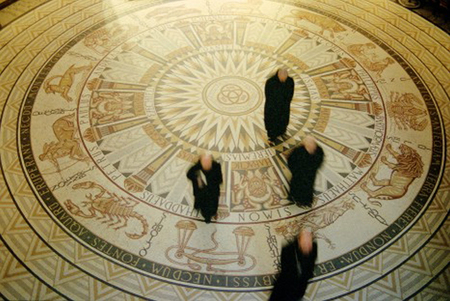 Fußbodenmosaik der Oberkirche
In the center three concentric bands mark the center of the creation. The light of the triune God, his truth and wisdom is carried out into the world by the greater and the lesser prophets and the apostles and evangelists. Additional bands are formed around the center until finally the ends of the earth are reached - graphically and in letters presented as the names of the twelve months and the twelve signs of the zodiac. The entire circular presentation is surrounded with a quotation from the Book of Proverbs:
Fußbodenmosaik der Oberkirche
In the center three concentric bands mark the center of the creation. The light of the triune God, his truth and wisdom is carried out into the world by the greater and the lesser prophets and the apostles and evangelists. Additional bands are formed around the center until finally the ends of the earth are reached - graphically and in letters presented as the names of the twelve months and the twelve signs of the zodiac. The entire circular presentation is surrounded with a quotation from the Book of Proverbs:
From of old I was poured forth, at the first, before the earth. When there were no depths I was brought forth, when there were no fountains or springs of water; before the mountains were settled into place, before the hills, I was brought forth.
(Proverbs 8:23-25)
The One who stands in the middle of the whole creation also holds it together!
The Apse Mosaic of the Choir Area
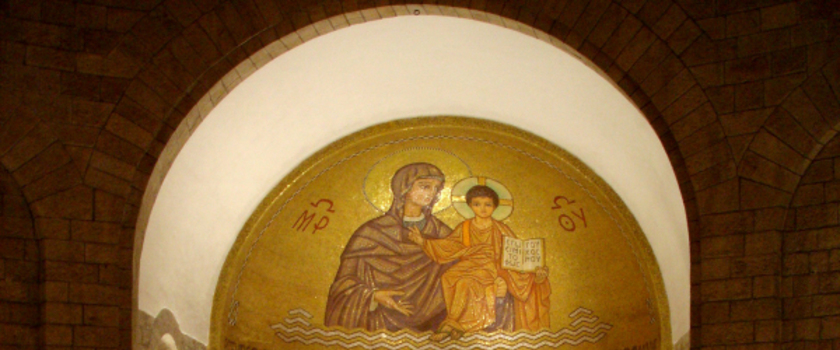 Apsismosaik des Chorraums
Apsismosaik des Chorraums
Again at the beginning of the Second World War, the monk and artist Radbod Commandeur from the Benedictine Abbey of Maria Laach created the large apse mosaic, which dominates the interior view of the upper church.
Four pairs of Old Testament prophets announce the birth of the Messiah. Their message culminates in the promise of the prophet Isaiah:
Therefore the Lord himself will give you this sign: the virgin shall be with child, and bear a son, and shall name him Immanuel (God with us).
(Isa 7:14).
The promised Son sits enthroned on the arm of his mother and announces with an open book:
I am the light of the world.
(John 12:46).
The marble slabs, which were planned as facing for the lower part of the apse, could not be transported from Germany to Palestine because of the war and were destroyed by bombing together with the Cologne Spedition, where they were stored.
The apse mosaic thus remains incomplete.
The Statue of Mary in the Crypt
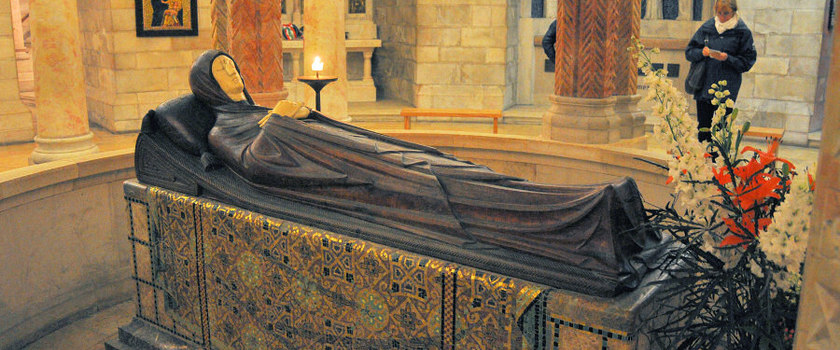 Marienfigur in der Krypta
Like the apse mosaic, the figure of the Dormition in the center of the crypt is also a work of Brother Radbod Commandeur OSB (Maria Laach).
Marienfigur in der Krypta
Like the apse mosaic, the figure of the Dormition in the center of the crypt is also a work of Brother Radbod Commandeur OSB (Maria Laach).
Daily hundreds of pilgrims kneel around the reclining statue of Mary, who dying looks toward her Son: from the cupola mosaic above her, He waits her with wide-open arms to take her up to heaven body and soul. He is surrounded by six women of the Old Testament, who walked with God in their own way, Eve and Miriam, Ruth and Esther, Jael and Judith.
Originally the gown of the figure of Mary was of chased silver and goldplated. After the war of 1948 and the occupation of the church only the wooden core remained. The ivory hands also had to be replaced and the nose in ivory had to be repaired.
The wars of human beings and their violence toward one another leave their traces also in the faces of the saints. Yet the wounds and needs of human beings have their place with the saints.
Our Organs
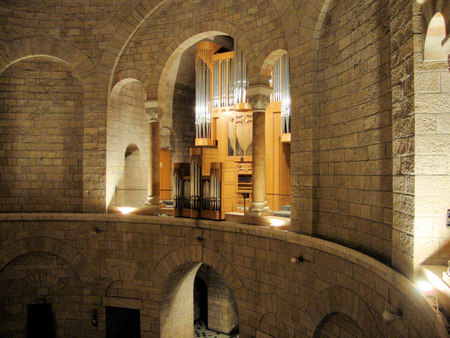 The praise of God is a central task of a Benedictine community. This takes place especially through the celebration of the divine liturgy, the celebration of the Eucharist and of the divine office (prayer of the hours). With the support and lead of an organ it is often simpler. The simple Gregorian chant and the power of the organ can often wonderfully complement each other.
The praise of God is a central task of a Benedictine community. This takes place especially through the celebration of the divine liturgy, the celebration of the Eucharist and of the divine office (prayer of the hours). With the support and lead of an organ it is often simpler. The simple Gregorian chant and the power of the organ can often wonderfully complement each other.
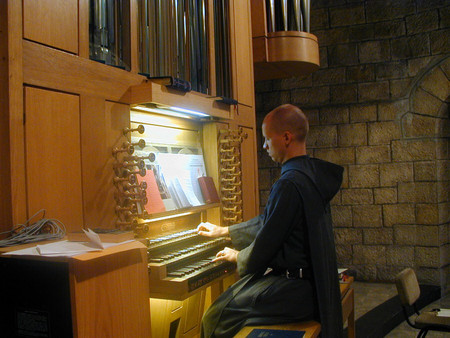 These tasks especially are fulfilled by our small choir organ and the great principal organ under the fingers of or house organists and of guest organists on ferial as well as feast days.
These tasks especially are fulfilled by our small choir organ and the great principal organ under the fingers of or house organists and of guest organists on ferial as well as feast days.
Especially the large principal organ has been since its dedication in 1982 a favorite instrument for concerts of sacred music in our church.